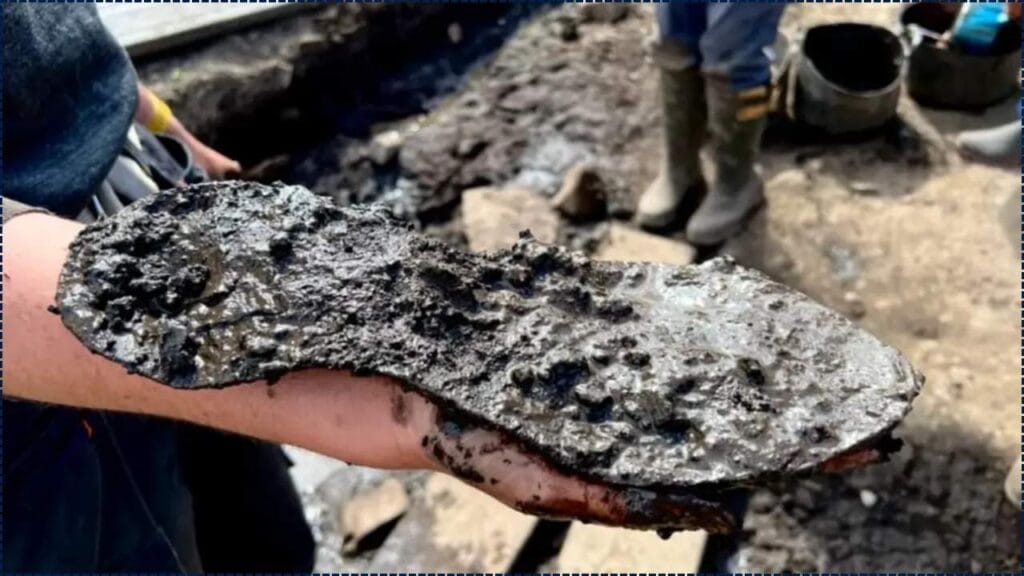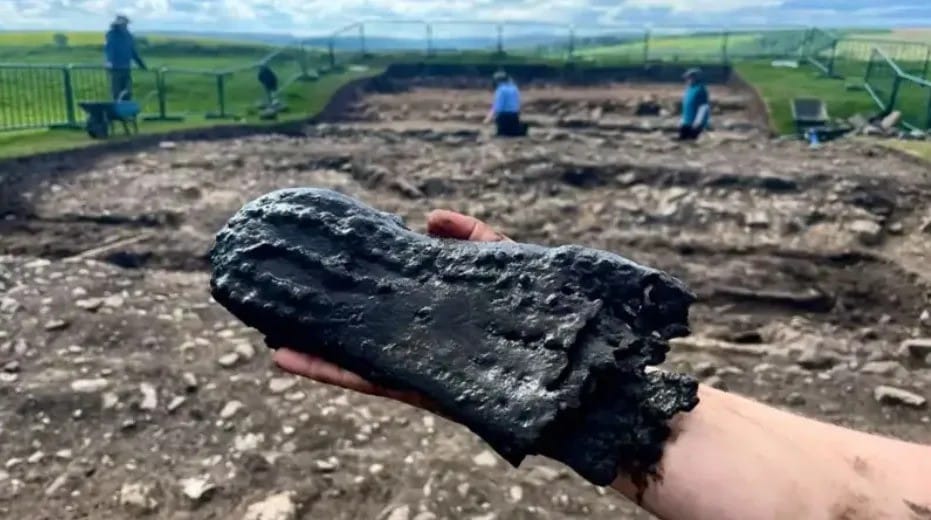Archaeologists Amazed by Giant Roman Shoe Unearthed at Magna Fort—this heartfelt discovery sparks wonder and curiosity about life in the ancient Roman world. During a routine dig at Magna Roman Fort in Northumberland, near England’s storied Hadrian’s Wall, a team uncovered a remarkable find: a 2,000-year-old leather shoe, an impressive 32 cm long—about a US men’s size 14, as grand as an NBA star’s!

This extraordinary relic invites us to connect with the past, marveling at the lives and stories of those who walked the edges of the Roman Empire with strength and humanity.
While Roman-era shoes have been found before, this one is in a class of its own for both its size and its preservation. What started as a dig through muddy trench layers quickly turned into a window into the past, offering clues about who wore it, what life was like in Roman Britain, and why this find matters now more than ever.
Archaeologists Stunned by Giant Roman Shoe
| Aspect | Details |
|---|---|
| Location | Magna Roman Fort, Northumberland, England |
| Discovery Date | June 2025 (announced publicly mid-June) |
| Item Found | Roman leather shoe measuring 32 cm long |
| Size Comparison | US men’s size 14; avg Roman male foot was US size 8.5 |
| Estimated Age | ~2,000 years old, likely late 1st or early 2nd century AD |
| Preservation Condition | Excellent, due to anaerobic (low-oxygen) waterlogged soil |
| Significance | Highlights physical variation among Roman troops; technological insight |
| Official Website | Vindolanda Trust |
A humble shoe—large, weathered, and untouched for 2,000 years—breathes new life into the story of Rome’s northern frontier. Found at Magna Fort near Hadrian’s Wall, this size-14 leather treasure is more than just ancient footwear. It’s a heartfelt testament to our ancestors’ diverse lives, their courage on rugged paths, and their enduring legacy. With every stitch, it weaves tales of resilience, adaptability, and deep global connections, inviting us to cherish the human spirit across time.
As researchers continue to dig, conserve, and interpret finds like this, we’re reminded that history lives in the details. And sometimes, those details come with hobnails.

What Exactly Was Found at Magna Fort?
A Shoe Fit for a Roman Titan
Among three shoes found in an ancient trench, one immediately caught researchers’ attention: a gigantic leather sandal with clear military-style hobnails on the sole. Measuring 32 cm in length (roughly 12.6 inches), it’s far larger than any previously discovered Roman footwear in Britain. The shoe was likely custom-made for a large soldier or officer stationed at the fort.
Why the Size Matters
The average Roman male was about 5’6″ with proportionate shoe sizes around US men’s 8.5. So this large find suggests either an exceptionally tall Roman, possibly from a northern European province, or even a mercenary recruited from outside the empire.
A Lucky Find
The shoe was found in what archaeologists call an “ankle-breaker trench”—a water-filled defensive trap designed to slow down intruders. The wet and oxygen-deprived conditions preserved the leather almost perfectly, including its stitching and iron hobnails, which are still embedded in the sole.
A Rich Glimpse into Roman Military Life
Roman Boots on the Ground
The Magna Fort played a strategic role along the Roman Empire’s northwestern frontier. Before Hadrian’s Wall was even built, troops at Magna were already stationed to secure trade routes and deter local resistance. Units here were known to include Syrian archers, Batavian infantry, and other auxiliary forces. The diversity of soldiers meant a mix of cultures—and possibly a variety of physical builds.
Other Finds From the Same Layer
The trench didn’t just yield this giant shoe. Archaeologists also found:
- More Roman shoes and sandals
- Iron tent pegs
- Pottery fragments
- Wooden combs
- A marble cosmetic palette, possibly used by a woman or a high-ranking officer
These daily-life items reveal the fort wasn’t just a military hub—it was a community, with cooking, grooming, trade, and family life all happening within its walls.
Engineering on Display
The multi-layered leather, combined with hobnails for grip, shows advanced Roman cobbling. It’s not just a shoe—it’s a technological artifact that demonstrates how Roman engineers designed footwear to withstand long marches, wet climates, and rough terrain.
Archaeologists Stunned by Giant Roman Shoe Breakdown of the Discovery Process
- Strategic Excavation: The Vindolanda Trust team chose a zone likely to contain frontier defenses. The ankle-breaker trench, known for its soggy base, was ideal for organic preservation.
- Unearthing the Unexpected: Volunteers first noticed dark, folded leather protruding from the mud. Careful removal revealed three Roman shoes, one of which measured significantly longer than expected.
- Measuring and Cataloguing: Once cleaned, the shoe was measured and logged. Its exceptional size triggered additional conservation protocols.
- Conservation and Testing: Stored in humidity-controlled containers, the shoe was transported to a lab where leather experts examined its grain, stitching, and wear patterns.
- Analysis in Context: Researchers compared the shoe to others found at Vindolanda and across Europe. The size suggests a new category of frontier soldier that historians hadn’t deeply considered before.
What Does This Discovery Mean for Us Today?
Makes History Feel Real
Artifacts like this connect us emotionally with people from the past. Clothing and shoes are intimate objects—they were shaped by the bodies that wore them. Holding or seeing one lets you imagine the real person, not just the abstract “Roman soldier.”
Shifting Historical Narratives
Roman soldiers weren’t a cookie-cutter mold. Some were local recruits; others came from across the vast empire. This shoe supports theories that the military was physically diverse, potentially even employing tall, burly men for specific tasks like heavy lifting or scouting.
Teaching with Tangibility
This find is already making its way into lesson plans and museum displays. 3D-printed replicas help kids compare their own shoes to ancient ones, and educators use it to talk about climate, archaeology, and empire.
Climate’s Double-Edged Role
Water saved this shoe. But with global climate change, drying soils might mean future finds won’t survive. Researchers are pushing for faster digs and better preservation funding to protect what’s still underground.
Related Links
Mysterious ‘Ghost’ Lineage Discovered In Tibet — DNA Study Reveals Ancient Human Secrets
Willpower Doesn’t Work? Don’t Worry! Check This Brain Trick to Adopt Habits Easily
Tips for Educators, Historians, and Students
- Explore Vindolanda Online: Visit vindolanda.com to explore photo galleries, research notes, and live updates from the site.
- Incorporate 3D Learning: Use available 3D scans of Roman artifacts to give students a tactile learning experience.
- Cross-Disciplinary Use: Blend history with science: analyze leather chemistry, trench soil composition, or even shoe biomechanics.
- Volunteer Opportunities: Anyone over 18 can join a dig at Vindolanda. It’s hands-on history and a rare chance to contribute to active archaeological work.
- Host a Community Night: Partner with libraries or schools to host “History Beneath Our Feet” events. Use the giant shoe as your centerpiece!
FAQs
Q: Is this the biggest Roman shoe ever found?
A: It’s among the largest in Britain and possibly Europe, though records vary. It’s definitely the best preserved at this size.
Q: Could the shoe belong to a centurion or officer?
A: Possibly. Officers often had better gear. But size alone doesn’t confirm status—it could’ve just been a very tall auxiliary soldier.
Q: Are these types of finds common?
A: Not at all. Leather degrades quickly unless preserved in special conditions like those at Magna.
Q: Will the shoe go on tour?
A: That’s under consideration. Once fully conserved, it may become part of a traveling Vindolanda exhibit.
Q: What’s next for Magna Fort?
A: More digs, deeper layers, and advanced scanning tech. There’s plenty left beneath the surface.








